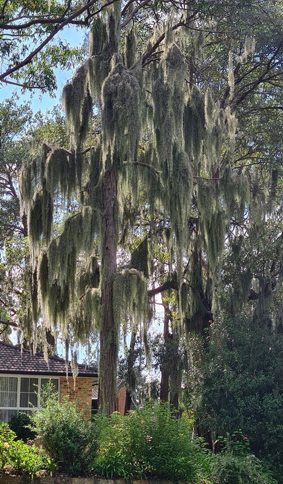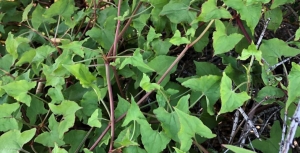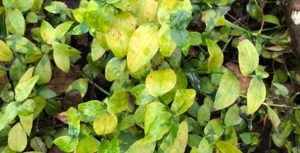Displaying items by tag: weed
Control
Spanish moss
Control
 We found no mention of an obvious biological control. Overseas examples of control include hand removal and spraying with potassium or sodium bicarbonate or copper sulphate.
We found no mention of an obvious biological control. Overseas examples of control include hand removal and spraying with potassium or sodium bicarbonate or copper sulphate.
Hand removal is often recommended as the best way to control Spanish moss but in our survey only approximately 12% was within easy reach. Rakes, ladders, professional tree climbers, industrial vacuum cleaners and specialised equipment such as spider lifts and elevated platforms would be needed in many infestations.
Spanish moss has been underestimated as a threat. We recommend that it be added to the next iteration of the Greater Sydney Regional Strategic Weed Management Plan, not be distributed or sold, and be added as a separate threat to Sydney Turpentine-Ironbark Forest in the Sydney Basin Bioregion.
Widespread education about its potentially disastrous impact on some bushland communities and urban forests is urgently needed through gardeners, horticulturalists, bushland managers and professional organisations.
Also, research is urgently needed into the ecology of Spanish moss, why it flourishes on some trees and not others, the ecological consequences of its presence as well as control methods suitable to Australian ecosystems and conditions.
Description
Spanish moss
Description
Spanish moss, commonly known as Old Man’s Beard, is a perennial monocotyledon in the pineapple family that grows abundantly from the Southern United States to the cooler regions of Argentina and Chile. It tolerates a huge range of temperatures and annual rainfall.
Spanish moss is an epiphyte that forms hanging festoons up to 8 m long which loop over branches and catch in cracks and crevices in bark to start new festoons. The festoons are made up of numerous shorter plants twisting around and overlapping each other.
It grows slowly, is not allelopathic nor drought tolerant, has low fertility requirements, is a medium moisture user, requires a pH of 6 to 6.9, has no salinity tolerance and is shade tolerant.
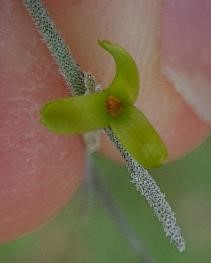
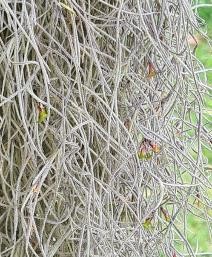
The small green flower is present from spring to autumn. The fruit is a capsule up to 25 mm long but we failed to find any mature fruit from November 2023 to June 2024. The flower rarely successfully self-pollinates. The seed is uncommon and is produced in autumn and winter. Seeds have feathery parachutes that enables them to float like dandelion seed. Seeds have no seed dormancy and can spread up to approximately 250 m away from the nearest Spanish moss but spread is not rapid under normal conditions.
The surface of Spanish moss plants is covered with tiny, grey scales (trichomes) that trap water and nutrients which then move by capillary action on the outside of the plant. Vascular transport is unimportant. Rain, dew and fog are more important than relative humidity. Water loss is reduced by crassulacean acid metabolism photosynthesis that allows gas exchange at night. In the Southern United States, Spanish moss is often found by ponds as clearing, frequent fires and barriers of dense pines prevent growth elsewhere. It generally grows best in high light conditions.
Spanish moss
Spanish moss
An environmental weed
In the early 2020s STEP became increasingly concerned about the potential impact of Spanish moss on our bushland and so we asked members to send us details of any Spanish moss growing on trees. In November 2024 we published the results of our findings in a booklet entitled Spanish Moss (Tillandsia usneoides): An Environmental Weed. A Preliminary Assessment in Northern Sydney.
We concluded that Spanish moss must be treated as a serious environmental weed otherwise turpentines, lilly pillys and other rainforest trees will turn into grey curtains of swaying Spanish moss. Local plant communities that are likely to be infected include the critically endangered Sydney Turpentine-Ironbark Forest, Blue Gum High Forest and Sydney Enriched Sandstone Moist Forest.
Threats to ecosystems include causing the death of individual trees by reducing photosynthesis but also include subtle effects such as altered water and nutrient cycles, changed predator prey interactions, habitat alteration, moderation of the microclimate and transformed fire regimes. Changes such as these are one of the greatest conservation threats to biodiversity in Australia.
Spanish moss will be expensive and difficult to control as most of it is out of easy reach. The sooner gardeners, park and natural area managers commence a coordinated program of removal the cheaper and more effective it will be.
Turkey rhubarb – another botanical name change
As reported in Regenavitus (newsletter of the Friends of Lane Cove NP), the botanical name of the pesky weed known as Turkey rhubarb has changed from Acetosa sagititta to Rumex sagitittus based on DNA research. Not another name change! Actually it has returned to its original name.
It has always been a mystery as to why this weed has been called Turkey rhubarb. Has it been mixed up with Rheum species that include the edible rhubarb?
According to Wikipedia the first known species is Rheum palmatum. It originated from western China, Tibet and Mongolia. During Islamic times, it was imported along the Silk Road, reaching Europe in the 14th century through the ports of Aleppo and Smyrna, where it became known as ‘Turkish rhubarb’ and also ‘Russian rhubarb’ and ‘Indian rhubarb’.
Its leaves are large, jagged and hand-shaped, growing in width to two feet. It can grow up to 2.5 m tall. So it is nothing like our ‘Turkey rhubarb’ except the flowers a vaguely similar. They didn’t have DNA analysis back in the 14th century. The flowers may be the answer?
It is primarily used in traditional medicine, and as an ornamental subject in the garden. The root of R. palmatum is known for its purported purging effects and suppressing fever. In ancient China, rhubarb root was taken to try to cure stomach ailments and as a ‘cathartic’ (an agent used to relieve constipation) and used as a poultice for ‘fevers and edema’ (swelling caused by fluid retention in the body tissues.
Do those large rhizomes that have to be dug up in order to remove our version of Turkey rhubarb also have medicinal qualities?
Trad fungus – a promising solution to rampant weed infestations
Tradescantia fluminensis, commonly known as wandering trad is one of the worst weeds in Sydney’s bushland and home gardens. This highly invasive weed rapidly takes over the ground layer in gullies and temporary watercourses, forming a thick blanket of leaves that excludes light and warmth. Trad aggressively smothers low plants and seedlings and cools the soil, preventing native plant germination and regeneration.
This plant spreads vegetatively, no seed is produced. Garden refuse dumped in bushland is a common form of spread. Stem fragments and roots readily wash down waterways or spread in mud from vehicles. Trying to remove trad is a very time-consuming process. Repeated follow up is required because a tiny stem or leaf left behind can regrow.
But now there is hope of a solution, a leaf-smut fungus called Kordyana brasiliensis. This agent was discovered on wandering trad during surveys in Brazil performed by researchers at the Universidade Federal de Viçosa. This exploratory research was part of the biocontrol program for this weed in New Zealand, led by Landcare Research.
After years of testing in Brazil, in New Zealand and in the CSIRO containment facility in Australia, researchers applied for approval to release the leaf smut fungus. They were granted approval by the Department of Agriculture and Water Resources in December 2018.
Researchers first released the leaf smut fungus at ‘nursery sites’ in the Dandenong Ranges during the cooler months of 2019. Nursery sites are areas where our staff will monitor the progress of the biocontrol agent to ensure it can survive and spread in the local area and is having a damaging effect on the wandering trad.
A new project from July 2020 to June 2023, co-funded by CSIRO and the NSW government through its Environmental Trust, is facilitating stakeholders’ releases of the fungus across the range of wandering trad in NSW. The project will also monitor the impact of the fungus on the weed and flow-on indirect impact on other vegetation at several sites during that period.
Ku-ring-gai Council is participating in the project and has released infected trad plants in several sites. It has been spreading rapidly in some sites such as the Gordon Flying Fox Reserve. The very damp conditions experienced over the past few months may be a factor. In other sites the spread has been fairly slow.
How it works
The leaf smut fungus (K. brasiliensis) spreads through spores, and it needs wandering trad leaves to survive. This pathogen enters wandering trad through the leave’s air holes (stomata), and slowly uses the weed’s energy for its own fungal growth. After two to three weeks, the leaves begin to develop yellow spots, caused by a lack of chlorophyll. Eventually the fungal infection is so severe that the wandering trad leaves die. The sick plant becomes less competitive against neighbouring native plants, giving them an advantage, and the opportunity to grow.
Don't worry, it's not another cane toad. It has been carefully tested by the CSIRO and only infects trad and not its close native relative Commelina which has blue flowers. The fungus needs the leaves of the wandering trad to survive – if there is no wandering trad to infect, the fungus dies.
Benefits of biocontrol agents
Biological control is the practice of managing a weed by deliberately using one or more of its natural enemies (biocontrol agents) to suppress it.
Specialised fungi, like the leaf smut, have specific genes that enable them to successfully infect and cause disease only on single or a narrow range of plant species. Testing involved looking at plants that are related to wandering trad including native plants to make sure the fungus will only infect the weed.
CSIRO field biologist Dr Ben Gooden, who is coordinating the rollout of the biocontrol program across Australia, said highly targeted and tested biocontrol agents like the fungus were a more environmentally sustainable option than other available tools. Scientifically tested biocontrol agents like this fungus provide a longer term, environmentally sustainable way of controlling weeds like wandering trad, without harming Australian plants or animals.
Thanks to the Facebook page of the Pittwater Natural Heritage Association and CSIROscope for some of this information.

